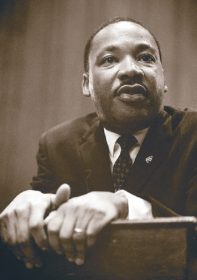Dr. Martin Luther King, Jr. was born in Atlanta, Georgia, on January 15,1929 in an area that, today, is a national historical site. His father was a minister and a prominent member of the community who served as a pastor at a nearby church. During King’s early days as a child, his parents attempted to shield him from some of the racial segregation policies characteristic of the time; however, racism permeated the atmosphere of his environment. A segregated society was a way of life that was even legalized by the United States Supreme Court in the famous case of Plessy v. Ferguson (1896), which established the important segregationist doctrine of “separate but equal.” Even after this doctrine was later repudiated by the Supreme Court in the momentous case of Brown v. Board of Education (1954), there was much to work for in terms of social justice.
 In some ways King was fortunate. He came from a prominent family and had the opportunity to receive a fine education. In 1948, he received his bachelor’s degree in sociology from Morehouse College, a prominent African-American institution located in Atlanta. Later he received his PhD from Boston University. King married Coretta Scott, and together they had four children. Coretta Scott King was to follow in King’s footsteps, also making important contributions to the civil rights movement.
In some ways King was fortunate. He came from a prominent family and had the opportunity to receive a fine education. In 1948, he received his bachelor’s degree in sociology from Morehouse College, a prominent African-American institution located in Atlanta. Later he received his PhD from Boston University. King married Coretta Scott, and together they had four children. Coretta Scott King was to follow in King’s footsteps, also making important contributions to the civil rights movement.
One of King’s most notable influences was Mahatma Gandhi, a great political leader who helped India gain independence from Great Britain. From Gandhi, King learned the value of use of passive resistance to influence society and obtain a very important goal. King decided to advocate for passive resistance and to use it in his attempt to bring about justice and racial equality in the U. S.
King first received national attention (as well as threats and indignities) as a result of his participatory leadership in the famous Montgomery Bus Boycott that began in 1955. History has described his efforts in the boycott as a major success foreshadowing future gains in the civil rights movement.
In April of 1963 King authored his famous “Letter From Birmingham Jail,” an excellent description and explanation of his philosophy to bring about social change in the U. S. In August of 1963, King gave his famous “I Have a Dream” speech before thousands in Washington, DC, expressing his desire for a time when his children might be judged by the content of their character and not by the color of their skin. In 1964, King received the Nobel Peace Prize, heightening his growing prominence on the national and international level. King was a key participant in the famous Selma March that led to the passage of the Voting Rights Act of 1965. Later he brought his advocacy of civil rights and equal opportunity to Chicago where he attempted to improve the quality of life for African Americans. His assassination in 1968 shocked the nation, but reinforced recognition of his accomplishments. King is buried in Atlanta, Georgia, the home of his birth. His tombstone reads, “Free at last, free at last, thank God Almighty, I’m free at last.”
King was not the only person to make substantial contributions to the civil rights movement in the U. S.; however, his legacies are enormous and important. King increased the political, economic, and social opportunities not only for African-Americans, but also for other minorities. He caused Americans and others to contemplate the effects of their behavior on the less fortunate in society. Finally, his efforts are a reminder that the price paid for equality is often going to be quite high; equal treatment is a public policy that does not come easily.
References:
- Cone, J. H. (1991). Martin & Malcom & America: A dream or a nightmare. New York: Orbis Books.
- Lischer, R. (1997). The preacher king: Martin Luther King, Jr. and the word that moved America. New York: Oxford University Press.
- McKnight, G. D. (1998). The last crusade: Martin Luther King, Jr., the FBI, and the poor people’s campaign. Boulder, CO: Westview Press.
- Pyatt, S. E. (1986). Martin Luther King, Jr.: An annotated bibliography. New York: Greenwood Press.
- Ralph, J. R. (1993). Northern protest: Martin Luther King, Jr., Chicago, and the civil rights movement. Cambridge, MA: Harvard University Press.
Like? Share it!
